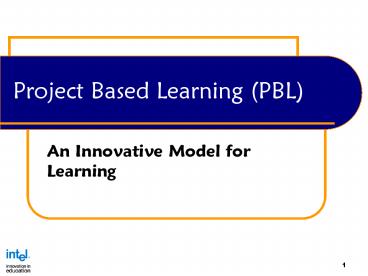Project Based Learning (PBL) - PowerPoint PPT Presentation
1 / 19
Title:
Project Based Learning (PBL)
Description:
Project Based Learning (PBL) An Innovative Model for Learning Characteristics of PBL Organizes standards-based curriculum around a meaningful open-ended problem or ... – PowerPoint PPT presentation
Number of Views:838
Avg rating:3.0/5.0
Title: Project Based Learning (PBL)
1
Project Based Learning (PBL)
- An Innovative Model for Learning
2
Characteristics of PBL
- Organizes standards-based curriculum around a
meaningful open-ended problem or project with
more than one approach or answer - Encourages active inquiry and higher-order
thinking skills - Engages students as stakeholders
- Creates a learning environment where teachers
coach, guide inquiry and facilitate deeper levels
of understanding - Concludes with realistic products
3
Project Based Learning
- emphasizes learning activities that are
- student-centered
- They become the problem solver, decisions maker,
investigator, documentarian - They take on the role of those working in a
particular discipline - long-term
- Projects can be a variety of lengths
- What they are not is one-day teacher centered
lessons - integrated with real world issues and practices
and have compelling questions - Significance beyond the classroom walls
4
Project Based Learning
- Develops real world skills
- many of the skills are those desired by today's
employer such as - the ability to work well with others
- make thoughtful decisions
- take initiative
- solve complex problems.
- Allows for a variety of learning styles
- accessible for all learners
5
The Students Move
- from following orders
- . . to carrying out self-directed
learning activities - from memorizing and repeating
- . . To discovering, integrating and
presenting - from listening and reacting
- . . To communicating and taking
responsibility
6
The Students Move
- from knowledge of facts, terms and content
- . . to understanding processes
- from theory
- . . to application of theory
- from teacher dependent
- . . to empowered
7
Methodology
- Guide on the side
- no longer sage on the stage
- More coaching and modeling
- less telling
- More finding out with students
- less being the expert
- More cross disciplinary thinking
- less specialization
- More performance-based assessment
- Less knowledge-based assessment
8
Project Based Learning and 21st Century Skills
- Project-based learning helps students develop
skills for living in a knowledge-based, highly
technological society. - Students make effective use of IT as they produce
a product, presentation, or performance - IT is integrated into the learning students are
NOT learning IT skills in isolation - technology is used to promote critical thinking
and communication
9
Differences in Project Based Learning and an
activity based lesson
10
Examples
11
Fourth Grade Science
- Goal understand how rocks are formed, learn
about the sources, properties and mineral
composition of indigenous rocks used in building
materials - Essential Question Where does this rock in my
hand fit into my life? - Project Students became geologists in their
town planning initiative whereby they are
responsible for what kind of native materials
planners might use to create streets, buildings,
pathways, and other structures
12
Upper Elementary/Middle School Science
- Goal Understand the different weather phenomena
that exist around the world - Essential Question What do we fear?
- Project Students will become weather
forecasters informing the world about different
weather phenomena and plans for being safe if
these phenomena are encountered.
13
Upper Elementary/Middle School/High School Math
- Goal Students will understand how the stock
market works and the effects on those involved - Essential Question How should I invest my money?
- Project Students will form companies, become
investors and or brokers, develop a plan for
investment and track investments for a year
14
Lets Try One
15
Lets Try One
16
The Design Process
- Start with the desired results
- What is important for students to do, know,
perform - What are the enduring understandings that are
needed? - What are the essential questions?
- Think about the evidence of learning
- How will you measure their understanding?
- What collective evidence using a variety of
formal and informal assessments will you use? - Plan the learning experiences
- Take a real-world topic and begin an in-depth
investigation - What activities will help the students gain the
knowledge and skills you have identified? - What strategies will you use?
17
References
- Friedman, P.D. Wilhelm, J.D.(1988).
Hyperlearning. New York Stenhouse Publishers. - Trowbridge, L.W. Bybee, R.W. (1996). Teaching
Secondary School Science. New Jersey Prentice
Hall - Vermillion, R.E. (1991). Projects and
Investigations. New York Macmillan Publishing Co.
18
Online Sources
- http//www.ericfacility.net/ericdigests/ed368509.h
tml - http//www.uoregon.edu/moursund/Math/pbl.htm
- http//www.jordan.palo-alto.ca.us/students/connect
ions/pbl/pblplan.html - http//eduscapes.com/tap/topic43.htm
- http//pblmm.k12.ca.us/PBLGuide/PBLPBL.htm
- http//www.iste.org/research/roadahead/pbl.htm
- http//www.glef.org/PBL/whypbl.htm
- http//www.bie.org
19
Online Sources
- http//college.hmco/education/pbl/background.htm
l - http//www.bie.org
- http//www.mcdenver.com/useguide/pbl.htm
- http//www.cord.org/lev2.cfm/56































